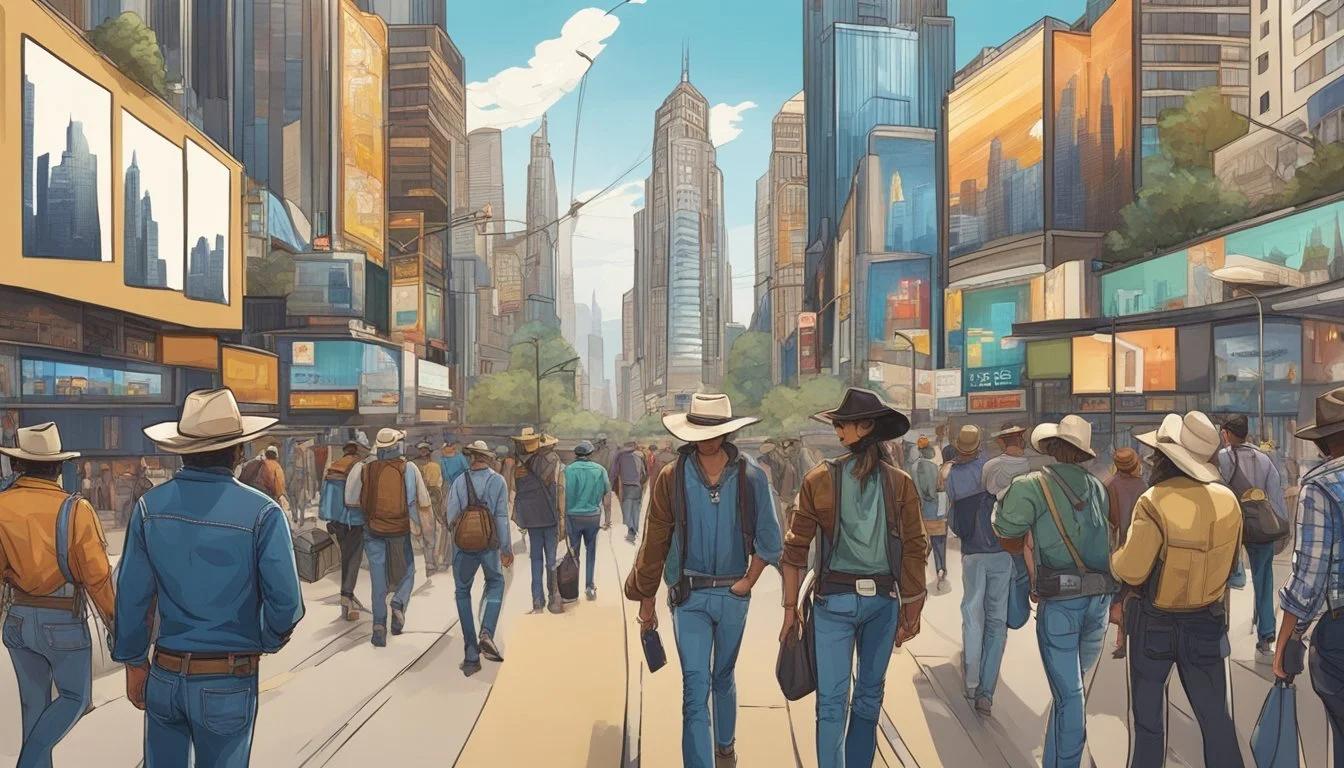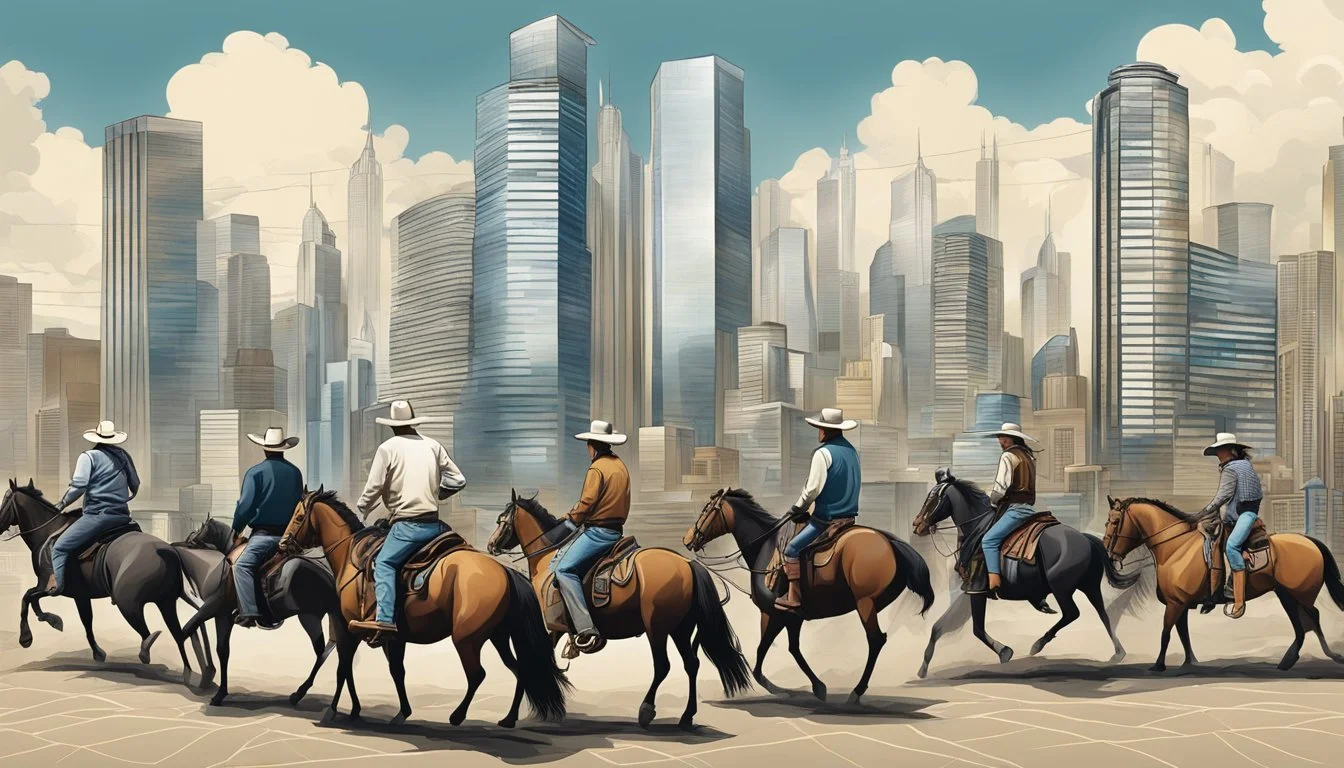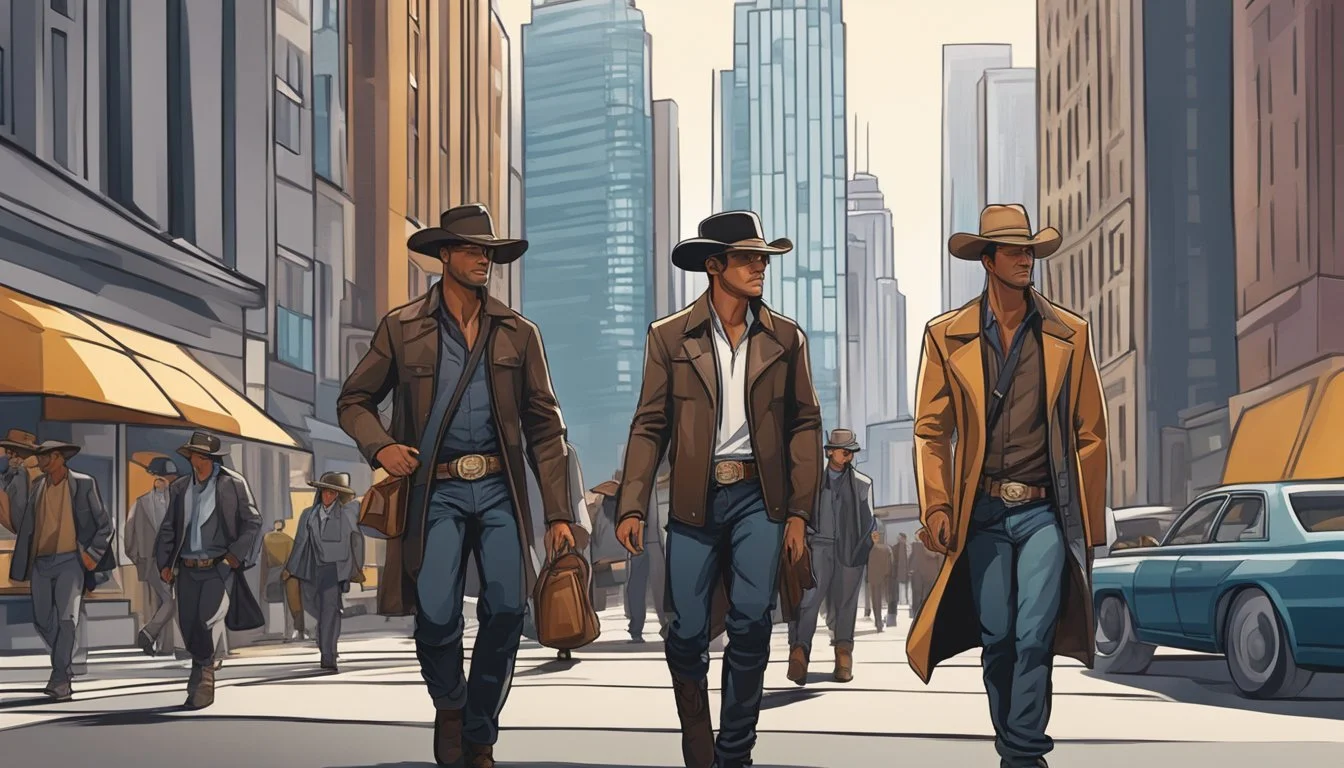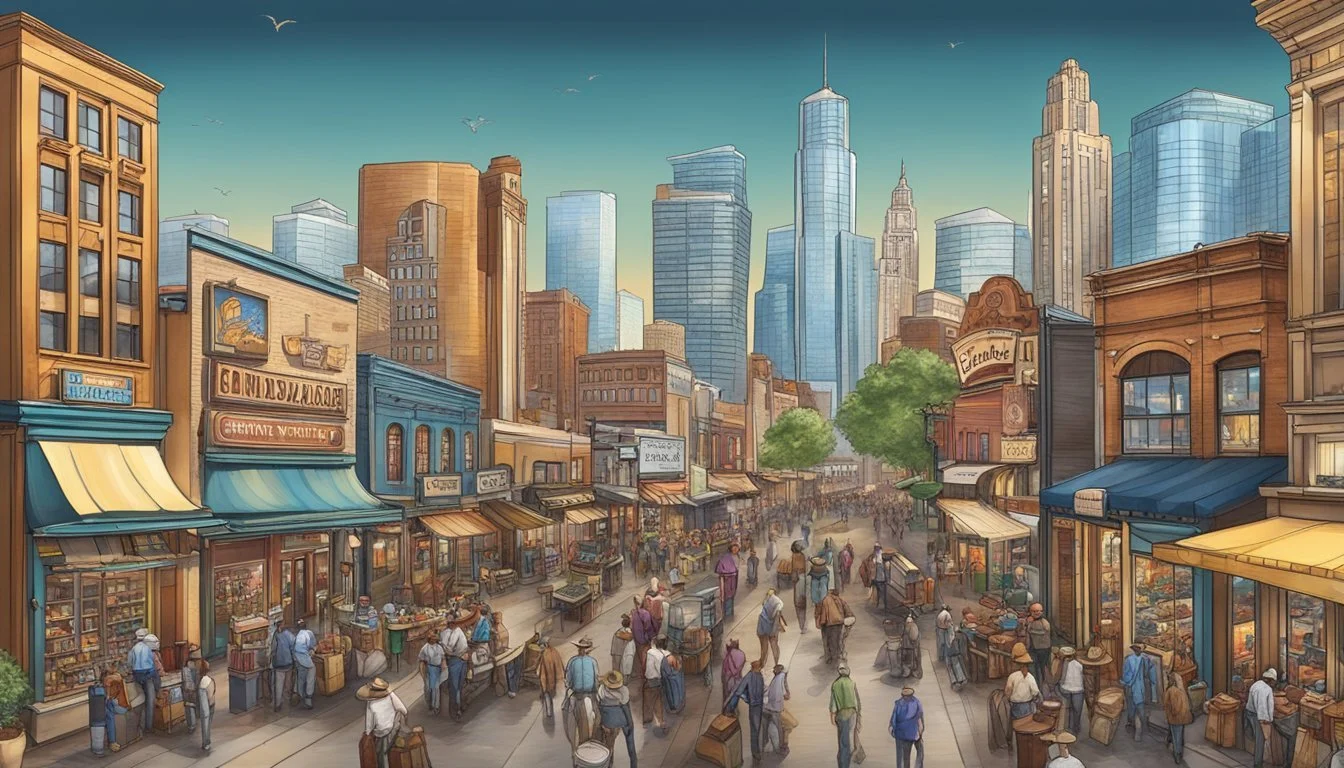The Rise of Urban Cowboys
Embracing the Western Lifestyle in Modern Metropolitan Settings
The urban cowboy phenomenon represents a cultural movement that saw city dwellers embracing elements of the western lifestyle, an aesthetic that was once exclusively linked to rural environments and ranch life. Tracing back to the late 20th century, notably influenced by the release and success of the 1980 film "Urban Cowboy," this trend riveted America as it blended traditional cowboy culture with an urban setting. The movie's impact was significant, not only at the box office but also in sparking a surge in the popularity of country music and western fashion in urban areas. The film's soundtrack featured tracks by celebrated country musicians, further cementing the alliance between country and pop music in the mainstream.
The urbanization of cowboy culture created a unique lifestyle where elements of the open range met concrete vistas. City residents found themselves drawn to the symbol of the cowboy as a figure of American tradition and resilience. This romanticized view led to an adoption of cowboy hats, boots, and even line dancing classes—components of a simpler life intertwined with the complexity of urban living.
While the surface of the movement can be seen in fashion choices and entertainment preferences, the essence of the urban cowboy lies in a deeper connection to nature and a yearning for simplicity amidst the bustling city life. This dichotomy reflects a broader cultural trend where individuals living in metropolitan areas gravitate towards nostalgic and iconic imagery rooted in a sense of heritage and freedom that the cowboy represents.
Historical Context
The evolution of cowboy culture from the open plains of the Wild West to the bustling city streets illustrates a significant transformation. This section delves into how the cowboy archetype transitioned into an urban phenomenon, reinforced by Hollywood's portrayal, and ignited the Urban Cowboy Movement.
From Wild West to Metropolitan Rodeo
The American West, once a wild frontier, established the cowboy as an emblem of rugged individualism and frontier survival. Cowboys were not just herdsmen; they became symbols of American values and folklore. As populations shifted from rural landscapes to urban centers, the cowboy persona was romanticized, creating an urban translation of the cowboy ethos.
Urban Cowboy Movement Origins
The Urban Cowboy Movement found its spark in the late 1970s and early 1980s as a cultural phenomenon. This trend was fueled by the 1980 film "Urban Cowboy," directed by James Bridges, which depicted the life of city-dwellers who adopted Western wear and engaged in activities such as line dancing. The movie's success catapulted the movement, highlighting an urban fascination with cowboy culture.
Hollywood's Influence on Cowboy Culture
Hollywood has been pivotal in crafting the cowboy image. John Travolta's role in "Urban Cowboy" brought the trend to a mainstream audience, inspiring a nationwide embrace of cowboy-related fashion and music. The film was adapted from an article, "The Ballad of the Urban Cowboy: America’s Search for True Grit," portraying a honky-tonk saloon in Houston as the epicenter for urban cowboys. This representation reinforced the cowboy's allure, transcending the American West's borders to permeate urban life.
Cinematic Impact
The emergence of urban cowboys in film has left a significant mark on American culture, particularly through influential movies that depict the unique blend of urban life with the traditional Western ethos.
Urban Cowboy: The Film that Started it All
Urban Cowboy, released in 1980, was a formative movie that introduced the concept of cowboys in a modern urban setting. Starring John Travolta as Bud Davis and Debra Winger as Sissy, the film unfolds the tale of a young man's journey from rural solitude to the complexities of city life in Houston, Texas. Bud Davis' character, with his authentic portrayal of a cowboy in the city, significantly influenced the public's perception of urban cowboys.
Box Office and Cultural Impact
Regarding financial success, Urban Cowboy was a box office hit. It resonated with audiences, leading to the trend of Western fashion in urban settings. The film grossed approximately $53 million at the domestic box office, reflecting its popularity. As a result, Urban Cowboy earned the status of a cult classic, with its influence permeating fashion, music, and nightlife, epitomized by the craze for country bars and mechanical bulls across America.
Key Figures and Characters
John Travolta (Bud Davis): As the charismatic leading man, Travolta's portrayal of Bud Davis captured the essence of the urban cowboy, navigating life and love in the city.
Debra Winger (Sissy): As Bud's love interest, Winger’s character epitomized the strength and resilience of a modern cowgirl adapting to urban challenges.
Scott Glenn (Wes): Playing the antagonist, Glenn's character highlighted the darker side of the urban cowboy lifestyle.
Madolyn Smith (Pam): Introduced as Bud's love interest apart from Sissy, Smith's character contributed a layer of complexity to the narrative.
Each actor delivered a performance that brought depth and authenticity to the film's representation of urban cowboy culture.
Fashion and Style
The fashion element of Urban Cowboy culture seamlessly blends traditional Western wear with the contemporary demands of city life. Its influence has spread far beyond the ranch, with key pieces becoming staples in urban wardrobes.
Western Wear in the Urban Jungle
Urban environments have witnessed an enduring embrace of Western fashion, with individuals integrating elements like cowboy boots and hats into their everyday attire. Not limited to costume or occasional wear, these pieces have found a permanent place in the urbanite's closet, a testament to the adaptability of Western wear in a modern setting.
Cowboy Boots and Hats
Cowboy boots have transitioned from practical ranch gear to fashionable city footwear, appearing in a wide range of materials from the classic leather to exotic snakeskin. Cowboy hats, while retaining their distinctive high crown and wide brim, now come in various styles, appealing to a diverse urban audience.
Materials for Boots and Hats:
Leather
Snakeskin
Suede
Embroidered Roses and Printed Western Shirts
The intricate details of Western shirts, often featuring embroidered roses, have garnered a significant following. Such shirts blend functionality with a touch of flair. Printed Western shirts continue to make a statement with their bold patterns and remain a favorite for those wanting to express a connection to cowboy heritage in their urban lifestyle.
Features of Western Shirts:
Embroidered floral patterns
Eye-catching prints
Durable fabrics
Western wear has established itself as an enduring style in urban settings, showcasing the timeless appeal of cowboy-inspired fashion.
Music and Dance
The resurgence of honky-tonk bars and the evolution of line dancing exemplify the urban cowboy era's influence on music and dance. Country music hit new highs with soundtracks that created hit songs, marking a cultural shift that embraced Western sensibilities.
Honky-Tonk Bars and Country Music
Honky-tonk bars served as the cornerstone for the rise of urban cowboys. Mickey Gilley's namesake bar, Gilley's Club, epitomized this trend, becoming a renowned venue that popularized country music within urban settings. It was not just a location for socializing but also a space where the sounds of the Charlie Daniels Band and other country music icons reverberated, marrying traditional music with the vibrancy of the city.
Line Dancing and Pop-Country Evolution
The trend towards line dancing received a significant boost during the urban cowboy movement. Following the disco-infused energy of "Saturday Night Fever," line dancing allowed city dwellers to partake in coordinated moves traditionally associated with country music. This paved the way for the fusion of country with pop influences, leading to what is now known as pop-country music. This genre gained further popularity with songs like "Old Town Road," demonstrating the lasting influence of the movement.
Soundtracks and Hit Songs
Film soundtracks played a pivotal role in disseminating country music beyond its traditional audience. The "Urban Cowboy" soundtrack was instrumental in this regard, featuring tracks that resonated with both country aficionados and newcomers to the genre. These compilations often resulted in songs topping the charts, solidifying country music's place within mainstream culture and elevating the status of Western-themed songs to hit status.
Social and Cultural Trends
This section explores the influence of the urban cowboy trend on social constructs like masculinity, the proliferation of honky-tonk culture in city settings, and how Nashville has stamped its mark on shaping this lifestyle into mainstream society.
Masculinity and the Modern Cowboy
The modern cowboy has become a symbol of rugged masculinity, threaded through the fabric of both rural and urban settings. This reinvention of the cowboy image, due to commercial success of related media, has allowed many to find a form of self-discovery and expression within a traditionally masculine archetype. It's a blend that sees men undertaking a journey similar to the rustic cowboy, but with an urban twist—adapting the ethos of openness and exploration to modern city life.
The Honky-Tonk Culture in Urban Settings
Honky-tonk culture has transitioned from its rural roots into urban nightlife, with city bars emulating the country western ambiance. These establishments offer alternative social venues where denim, boots, and the twang of guitars set the scene for a subculture steeped in realism, as opposed to the commonplace urban club experience. This consumption of honky-tonk aesthetics in cities underlines the lifestyle's broader appeal—and its tangible connection to a historic past.
Nashville's Influence on Urban Cowboy Lifestyle
Nashville, recognized as the heart of country music, has played a pivotal role in injecting the urban cowboy lifestyle into mainstream culture. Its distinct musical and fashion influences have evolved beyond the boundaries of alternative scenes to achieve widespread commercial success. The city's signature style has been crucial in shaping the urban cowboy—not only through sound but through a look and attitude that resonates with those seeking authenticity in a modern setting.
Entertainment and Recreation
The urban cowboy phenomenon brings the rugged charm of the Western lifestyle to the heart of the city, combining traditional rodeo recreation with modern entertainment venues known for their country flair.
Mechanical Bulls and Rodeos
Mechanical bull riding, a popular activity in Western-themed bars and clubs, challenges participants to a simulated rodeo experience. Gilley's Club gained notoriety for popularizing mechanical bull riding, giving rise to a trend that persists in entertainment locales, where enthusiasts and curious city-dwellers alike test their skills.
Location: Urban clubs and bars
Purpose: Entertainment, skill simulation
Popularity Signal: Featured in "Urban Cowboy" film
Country Lifestyle as Leisure
Adopting the country lifestyle as a form of leisure, city residents enjoy activities such as line dancing and wearing traditional Western attire. Events like rodeos draw crowds, offering a slice of cowboy culture through competitive and exhibition performances that harken back to the skills of the American frontier.
Attire: Cowboy boots, hats, pearl snaps
Activities: Line dancing, Western fashion exhibitions
Cultural Impact: Merges rural traditions with urban entertainment
Gilley's Club and its Legacy
Gilley's Club, made famous by the "Urban Cowboy" movie, epitomizes the blend of city life with country culture. This venue catalyzed the urban cowboy trend, highlighting how a single establishment's legacy can influence broader entertainment trends, with patrons still donning cowboy-inspired wear for a night out.
Inception: Influenced by 1980 film "Urban Cowboy"
Impact: Sparked interest in Western fashion, country music
Continuity: Remains a cultural symbol for the urban cowboy lifestyle
Economic Aspects
The Western lifestyle has carved out a significant niche in the urban market, shaping both fashion and music industries with an influence potent enough to be measured in billions.
The Western Lifestyle Market
The fusion of urban life with Western style has manifested into a thriving market, with conservative estimates valuing the industry at $5 billion. This includes a myriad of products from clothing to accessories that cater to consumers attracted to the rugged and resilient imagery of the cowboy aesthetic.
The Impact of 'Urban Cowboy' on Fashion and Music Industries
The release of "Urban Cowboy" marked a pivotal point for Western-themed fashion and music, funneling them into the mainstream. The movie's commercial success translated to a heightened demand for cowboy boots, hats, and buckles, deeply influencing Wall Street projections. Moreover, its soundtrack, which featured prominent country artists, saw remarkable sales, further cementing the genre's position in the Billboard charts and expanding its reach to a broader audience.
Expansion of the Cowboy Merchandise
Retailers and fashion designers swiftly responded to the demand spike, expanding their inventory to include Western wear suitable for city life. The style's resilience on fashion runways and its prevalent display in urban settings signifies the solid stake Western themes hold in commercial merchandise, underscoring the tangible economic impact of the urban cowboy phenomenon.
Contemporary Perspectives
The urban cowboy trend has seen a resurgence, deeply influencing modern fashion, entertainment, and lifestyle choices within the urban landscape.
Revival of Urban Cowboy Aesthetic
The iconic urban cowboy aesthetic, characterized by spangly shirts and cowboy boots, has been revived among city dwellers. Fashion-forward individuals blend traditional Western attire with contemporary styles, showcasing how the rugged spirit of the cowboy era now permeates urban fashion sensibilities. Celebrities like Lil Nas X can be seen embracing this trend, often sporting flashy Western outfits that echo the cowboy's boldness.
Influence on 21st Century Pop Culture
Western influence extends beyond clothing, leaving its mark on 21st-century pop culture. Music genres traditionally associated with cowboys, like country, have witnessed a crossover with modern styles. Joe Walsh and the Eagles, with their blend of rock and country sounds, can be seen as precursors to this movement. Modern artists bridge these worlds, with Lil Nas X fusing country themes with hip-hop elements, pushing the cowboy image into new, diverse audiences. Movies and television often revisit cowboy narratives, though without the glorified violence typical of earlier westerns.
Urban Ranching and Modern Interpretations
The concept of urban ranching presents a modern take on the cowboy lifestyle, integrating aspects of ranch life into urban settings. From rooftop gardens mimicking traditional farming practices to community initiatives resembling cattle drives, city inhabitants are inventing new ways to capture the essence of the cowboy spirit. Dance halls and bars, reminiscent of classic cowboy social spots, also adapt to urban settings, allowing city residents to engage in country-style recreation despite the surrounding oil refinery and concrete jungle.







